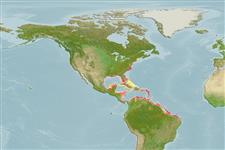>
Tetraodontiformes (Puffers and filefishes) >
Diodontidae (Porcupinefishes (burrfishes))
Etymology: Chilomycterus: Greek, cheilos = lip + Greek, mykter, -eros = nose (Ref. 45335).
Eponymy: Dr Johann David Schoepf (1752–1800) was a German botanist, zoologist and physician. [...] (Ref. 128868), visit book page.
More on author: Walbaum.
Environment: milieu / climate zone / depth range / distribution range
Ecología
marino asociado a arrecife; rango de profundidad 1 - 11 m (Ref. 9710). Tropical; 46°N - 5°S, 98°W - 34°W
Western Atlantic: Nova Scotia (Canada), Maine (USA), Bahamas, and northern Gulf of Mexico to Brazil. Uncommon or absent from most of West Indies.
Tamaño / Peso / Age
Maturity: Lm ? range ? - ? cm
Max length : 27.9 cm TL macho / no sexado; (Ref. 40637); peso máximo publicado: 630.00 g (Ref. 4699)
No spines wholly on caudal peduncle. Supraocular tentacles absent or much smaller than eyes. 5 to 7 large dark blotches on back and sides, with many, approximately parallel to obliquely intersecting dark lines distributed over light background colour. No small, dark spots either on body or fin (Ref 53034).
Very common in seagrass beds in bays and coastal lagoons. Also found on shallow coastal reefs (Ref. 9710). Has been traded as an aquarium fish at Ceará, Brazil (Ref. 49392).
Life cycle and mating behavior
Madurez | Reproducción | Puesta | Huevos | Fecundidad | Larva
Robins, C.R. and G.C. Ray, 1986. A field guide to Atlantic coast fishes of North America. Houghton Mifflin Company, Boston, U.S.A. 354 p. (Ref. 7251)
IUCN Red List Status (Ref. 130435: Version 2024-1)
Threat to humans
Harmless
Human uses
Pesquerías: sin interés; pesca deportiva: si; Acuario: Comercial
Herramientas
Special reports
Download XML
Fuentes de Internet
Estimates based on models
Preferred temperature (Ref.
123201): 18.4 - 28, mean 26.9 °C (based on 501 cells).
Phylogenetic diversity index (Ref.
82804): PD
50 = 0.5313 [Uniqueness, from 0.5 = low to 2.0 = high].
Bayesian length-weight: a=0.04677 (0.01905 - 0.11483), b=2.82 (2.61 - 3.03), in cm total length, based on LWR estimates for this (Sub)family-body shape (Ref.
93245).
Nivel trófico (Ref.
69278): 3.5 ±0.37 se; based on food items.
Resiliencia (Ref.
120179): Alto, población duplicada en un tiempo mínimo inferior a 15 meses (Preliminary K or Fecundity.).
Fishing Vulnerability (Ref.
59153): Low vulnerability (18 of 100).
Nutrients (Ref.
124155): Calcium = 52 [22, 127] mg/100g; Iron = 0.646 [0.310, 1.460] mg/100g; Protein = 18.4 [16.2, 20.5] %; Omega3 = 0.1 [0.1, 0.2] g/100g; Selenium = 26.3 [13.2, 55.5] μg/100g; VitaminA = 58.8 [17.0, 209.9] μg/100g; Zinc = 1.19 [0.79, 1.80] mg/100g (wet weight);
